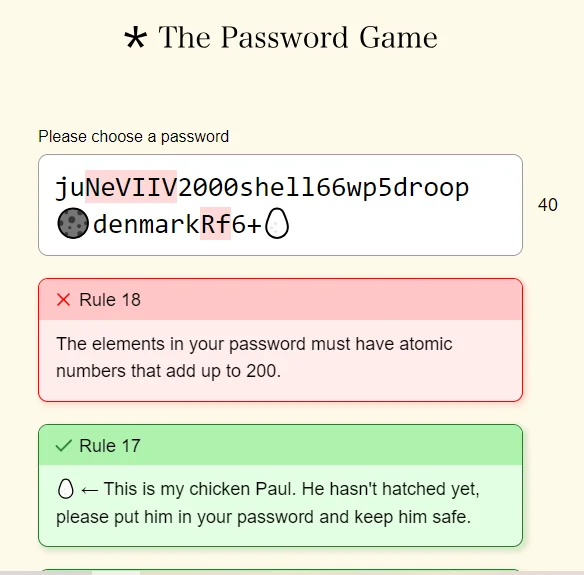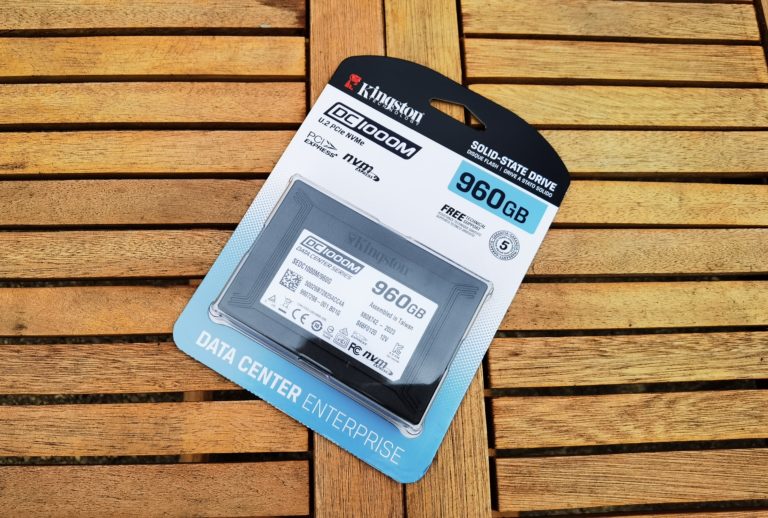Any links to online stores should be assumed to be affiliates. The company or PR agency provides all or most review samples. They have no control over my content, and I provide my honest opinion.
Rule 18 in The Password Game presents a unique challenge that requires players to incorporate chemical elements into their password, with the atomic numbers of these elements adding up to exactly 200. Here’s a detailed guide on how to tackle this rule:
Previous Password Game Rules
- Password Game Rule 9 Guide: Which Roman Numerals Multiply to 35?
- How to Beat Password Game Rule 12: Two-Letter Periodic Table Symbols
- Detailed Guide for Password Game Rule 14: “Your password must include the name of this country”
- Password Game Rule 16: What is the best move in algebraic chess notation?
Understanding Rule 18

Rule 18 identifies chemical elements in your password based on their symbols from the periodic table. It considers both single uppercase letters and uppercase-lowercase combinations as potential elements[1].
Strategy for Success
- Identify existing elements: Look at the highlighted letters in your password to see which elements are already present[1].
- Calculate current total: Add up the atomic numbers of the elements you’ve identified.
- Determine the target: Subtract your current total from 200 to know what additional atomic numbers you need.
- Choose new elements: Select elements whose atomic numbers will help you reach 200 when added to your existing total.
- Adjust as needed: You may need to remove or change some elements to reach exactly 200.
Tips and Considerations
- Use a spreadsheet: Keep track of your elements and their atomic numbers to make calculations easier[1].
- Lowercase strategy: You can change uppercase letters to lowercase to remove unwanted elements without altering your password significantly[1].
- Element selection: Consider using elements with higher atomic numbers to reach 200 more quickly, but be mindful of other rules[1].
- Avoid conflicts: Be cautious of elements that use letters also used as Roman numerals (C, D, I, L, M, V, X) as they can interfere with other rules[1].
Practical Approach
- Start with existing elements: For example, if your password contains “Na” (Sodium, atomic number 11) and “Fe” (Iron, atomic number 26), your starting total is 37.
- Add high-value elements: To quickly approach 200, consider adding elements like:
- Pb (Lead, 82)
- Bi (Bismuth, 83)
- Po (Polonium, 84)
- At (Astatine, 85)
- Fine-tune with lower-value elements: Use elements with smaller atomic numbers to reach exactly 200. For instance:
- H (Hydrogen, 1)
- He (Helium, 2)
- Li (Lithium, 3)
- Adjust other rules: You may need to modify other parts of your password to accommodate the new elements while still satisfying previous rules.
Periodic Table With Symbols and Atomic Numbers
| Element | Symbol | Atomic number |
| Hydrogen | H | 1 |
| Helium | He | 2 |
| Lithium | Li | 3 |
| Beryllium | Be | 4 |
| Boron | B | 5 |
| Carbon | C | 6 |
| Nitrogen | N | 7 |
| Oxygen | O | 8 |
| Fluorine | F | 9 |
| Neon | Ne | 10 |
| Sodium | Na | 11 |
| Magnesium | Mg | 12 |
| Aluminium | Al | 13 |
| Silicon | Si | 14 |
| Phosphorus | P | 15 |
| Sulfur | S | 16 |
| Chlorine | Cl | 17 |
| Argon | Ar | 18 |
| Potassium | K | 19 |
| Calcium | Ca | 20 |
| Scandium | Sc | 21 |
| Titanium | Ti | 22 |
| Vanadium | V | 23 |
| Chromium | Cr | 24 |
| Manganese | Mn | 25 |
| Iron | Fe | 26 |
| Cobalt | Co | 27 |
| Nickel | Ni | 28 |
| Copper | Cu | 29 |
| Zinc | Zn | 30 |
| Gallium | Ga | 31 |
| Germanium | Ge | 32 |
| Arsenic | As | 33 |
| Selenium | Se | 34 |
| Bromine | Br | 35 |
| Krypton | Kr | 36 |
| Rubidium | Rb | 37 |
| Strontium | Sr | 38 |
| Yttrium | Y | 39 |
| Zirconium | Zr | 40 |
| Niobium | Nb | 41 |
| Molybdenum | Mo | 42 |
| Technetium | Tc | 43 |
| Ruthenium | Ru | 44 |
| Rhodium | Rh | 45 |
| Palladium | Pd | 46 |
| Silver | Ag | 47 |
| Cadmium | Cd | 48 |
| Indium | In | 49 |
| Tin | Sn | 50 |
| Antimony | Sb | 51 |
| Tellurium | Te | 52 |
| Iodine | I | 53 |
| Xenon | Xe | 54 |
| Cesium | Cs | 55 |
| Barium | Ba | 56 |
| Lanthanum | La | 57 |
| Cerium | Ce | 58 |
| Praseodymium | Pr | 59 |
| Neodymium | Nd | 60 |
| Promethium | Pm | 61 |
| Samarium | Sm | 62 |
| Europium | Eu | 63 |
| Gadolinium | Gd | 64 |
| Terbium | Tb | 65 |
| Dysprosium | Dy | 66 |
| Holmium | Ho | 67 |
| Erbium | Er | 68 |
| Thulium | Tm | 69 |
| Ytterbium | Yb | 70 |
| Lutetium | Lu | 71 |
| Hafnium | Hf | 72 |
| Tantalum | Ta | 73 |
| Tungsten | W | 74 |
| Rhenium | Re | 75 |
| Osmium | Os | 76 |
| Iridium | Ir | 77 |
| Platinum | Pt | 78 |
| Gold | Au | 79 |
| Mercury | Hg | 80 |
| Thallium | Tl | 81 |
| Lead | Pb | 82 |
| Bismuth | Bi | 83 |
| Polonium | Po | 84 |
| Astatine | At | 85 |
| Radon | Rn | 86 |
| Francium | Fr | 87 |
| Radium | Ra | 88 |
| Actinium | Ac | 89 |
| Thorium | Th | 90 |
| Protactinium | Pa | 91 |
| Uranium | U | 92 |
| Neptunium | Np | 93 |
| Plutonium | Pu | 94 |
| Americium | Am | 95 |
| Curium | Cm | 96 |
| Berkelium | Bk | 97 |
| Californium | Cf | 98 |
| Einsteinium | Es | 99 |
| Fermium | Fm | 100 |
| Medelevium | Md | 101 |
| Nobelium | No | 102 |
| Lawrencium | Lr | 103 |
| Rutherfordium | Rf | 104 |
| Dubnium | Db | 105 |
| Seaborgium | Sg | 106 |
| Bohrium | Bh | 107 |
| Hassium | Hs | 108 |
| Meitnerium | Mt | 109 |
| Darmstadtium | Ds | 110 |
| Roentgenium | Rg | 111 |
| Copernicium | Cn | 112 |
| Nihonium | Nh | 113 |
| Flerovium | Fl | 114 |
| Moscovium | Mc | 115 |
| Livermorium | Lv | 116 |
| Tennessine | Ts | 117 |
| Oganesson | Og | 118 |
Example
Let’s say your current password is “Na1Fe2!” with a total of 37. To reach 200, you could add:
- Pb (82) + Bi (83) = 165
- Li (3) = 168
- S (16) + O (8) + Ne (10) = 202
Then remove “Na” to bring the total back to 200.
Your new password might look like: “1Fe2PbBiLiSONe!”
Remember, this rule interacts with others, so you may need to make adjustments to satisfy multiple rules simultaneously. Be patient and methodical in your approach, and don’t hesitate to make changes to your password as needed to meet all the requirements[1].
By following these steps and tips, you should be able to successfully navigate Rule 18 in The Password Game and continue your progress towards completing this challenging puzzle.
How many rules are there in the Password Game?
The Password Game has a total of 35 rules or levels that you must complete to win the game. Here are the key details:
- There are 35 rules in total that your password must follow.
- The rules start out simple but become increasingly complex and absurd as you progress.
- You must satisfy all previous rules while following each new rule that is introduced.
- Some of the more challenging rules include:
- Adding the current phase of the moon as an emoji (Rule 13)
- Identifying a country from a Google Street View image (Rule 14)
- Including the best chess move in algebraic notation (Rule 16)
- Making the atomic numbers of elements in your password add up to 200 (Rule 18)
- Keeping an emoji chicken alive by feeding it (Rules 17 & 23)
- The final challenge comes at Rule 35, where you must retype your entire complex password from memory within 2 minutes after confirming it’s your final password.
- Copying and pasting is not allowed for the final challenge – you must manually type the entire password.
How to beat the Password Game?
Winning The Password Game requires you to meet increasingly bizarre and complex rules that get added with each level. Here are some general tips and strategies to help you get through the game successfully:
1. Follow the Rules in Order:
Each rule builds upon the previous ones, so following them in sequence is crucial. Adding components in the wrong order could force you to redo sections of your password.
2. Keep Track of Your Password:
Each new rule may change the requirements, making it necessary to adjust previously entered sections. Copy and paste your password somewhere safe as you go along so you don’t lose progress.
3. Understand Common Rules:
The game throws increasingly strange rules at you, but many of them are logic-based. Some typical rules include:
- Case-sensitivity: The password must include a combination of upper and lower case letters.
- Special characters: Often, you’ll need to include punctuation marks like
!,@,#, etc. - Roman numerals: As you’ve seen, Roman numerals may be required to meet mathematical conditions (e.g., they multiply to a certain number).
- Binary or other numerical systems: You might be asked to include specific digits in binary, hexadecimal, or other number systems.
- Leetspeak: Converting letters to numbers or special characters (e.g., A becomes 4, E becomes 3, etc.).
- Special dates: Such as including the Unix epoch or today’s date.
4. Make Space for Unexpected Requirements:
As the rules get weirder, you might need to include emojis, references to outside events (like a stock ticker or weather), or specific word combinations. Keep space in your password for these and be flexible about structure.
5. Use Resources:
For rules that involve mathematics (like Roman numeral multiplication), special characters, or logic puzzles, you may need to use online tools or calculators:
- Roman numeral converters
- Binary to decimal converters
- Date and time format generators
6. Be Prepared for External References:
Some rules might involve referencing real-world data, like a specific website’s current status (such as Google’s stock price or the position of the International Space Station). You may need to check the actual real-time data to comply with these rules.
7. Iterate and Adapt:
It’s not unusual to have to backtrack in the game. As new rules get introduced, you may need to adjust earlier parts of your password to fit all of the criteria. Adaptation is key.
8. Memorize and Stay Calm:
Stay calm even as the rules become increasingly ridiculous. Each step is designed to test your adaptability. Memorize or write down key parts of your password so you can reconstruct it quickly if necessary.
Example Winning Strategy:
- Start Simple: Follow basic rules like including letters, numbers, and symbols.
- Incorporate Roman Numerals: For rules involving Roman numerals (e.g., multiplication to a specific number), use converters and calculators to find the right numerals.
- Handle Special Characters and Dates: Add special dates in the specified format, making sure they don’t conflict with other parts of the password.
- Prepare for Unexpected Additions: Leave room for emoji or real-world references, like the weather or stock prices.
- Keep Adapting: Adjust the earlier parts of your password as new, more complex rules get introduced.
Winning The Password Game is as much about creativity and patience as it is about problem-solving. Keep these strategies in mind, and good luck!
I am James, a UK-based tech enthusiast and the Editor and Owner of Mighty Gadget, which I’ve proudly run since 2007. Passionate about all things technology, my expertise spans from computers and networking to mobile, wearables, and smart home devices.
As a fitness fanatic who loves running and cycling, I also have a keen interest in fitness-related technology, and I take every opportunity to cover this niche on my blog. My diverse interests allow me to bring a unique perspective to tech blogging, merging lifestyle, fitness, and the latest tech trends.
In my academic pursuits, I earned a BSc in Information Systems Design from UCLAN, before advancing my learning with a Master’s Degree in Computing. This advanced study also included Cisco CCNA accreditation, further demonstrating my commitment to understanding and staying ahead of the technology curve.
I’m proud to share that Vuelio has consistently ranked Mighty Gadget as one of the top technology blogs in the UK. With my dedication to technology and drive to share my insights, I aim to continue providing my readers with engaging and informative content.







